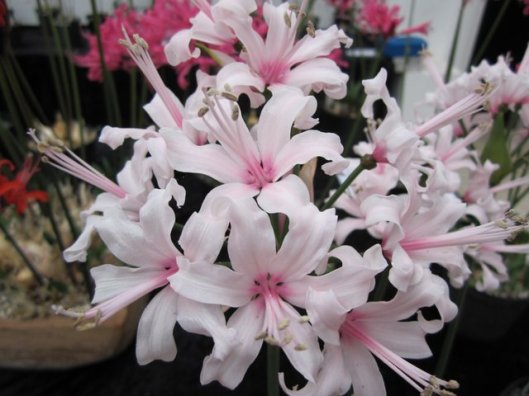I was in Guernsey at the invitation of the local branch of Plant Heritage – one of those relatively low-profile charities beavering away behind the scenes doing the kind of work you only realise has been done when you come across some dreadful situation they have averted. In PH’s case, that almost always means some wonderful variety of hardy chrysanthemum, or pulmonaria, or hemerocallis or hebe which everyone’s suddenly talking about yet it emerges only survives because a PH volunteer has lovingly kept it alive, properly identified and labelled, in their back garden. It’s a bit like the Heritage Seed Library, but for garden plants.
I’ve been a Plant Heritage (formerly NCCPG) member for many, many years and indeed was on the committee of the Surrey Group in my day – so I have first-hand knowledge of the extraordinary, and largely unsung work they do in keeping hundreds of cultivated garden plants in circulation which would otherwise have been lost to us.
They do this largely through the National Collections. These are held wherever there is space for them: in the homes of amateur gardeners, big public gardens like RHS Wisley, or in this case a spare glasshouse rented from Guernsey Clematis.
Actually, this is a nearly-National Collection: since 1993 members of PH Guernsey have been tracking down cultivars, common and then increasingly rare, of the wonderful Guernsey lily and bringing them together, documenting them to PH’s painstaking standards of record-keeping, in the hope (well-founded) of registering them as a bona fide National Collection.
These aren’t just any Guernsey lilies, either. You are probably familiar with Nerine x bowdenii, lipstick pink stalwart of the dry, rocky, sunny corner by the house where nothing else will grow. That, to be quite honest with you, is a bruiser by comparison with the Rudolph Nureyev elegance of N. sarniensis: an exquisite confection of dainty petals held just so above a tall, elegantly swaying yet wiry stem.
I have one at home, N. s. ‘Blanchefleur’; I have raved about it before on this very blog. It is one of the few plants in my garden which is neither edible nor particularly useful: but it is exceptionally beautiful, the kind of beauty that makes you gasp every time you see it. Sarniensis nerines (named for Guernsey’s ancient title, Sarnia, although originally South African) have the extraordinary ability to reflect light from their petals, making them gleam and sparkle – a phenomenon the Victorians called gold (or silver) dusting. They make you do a double-take every time the winter sun hits them.
And that’s when they flower: in winter, or nearly. Mine starts in late October and is usually still going in December (this year, it being so mild, it only finished in February). They have to stay indoors, as they’re frost tender: I keep mine in pride of place in the greenhouse, but I used to keep it on a bright windowsill and it was fine there, too.
‘Blanchefleur’ is considered among the easier of sarniensis varieties to grow (that explains why it’s so tolerant of me, then). But having now seen what else is out there I think I will have to start my own collection. Breeders like Ken Hall, on the Isle of Wight, and the de Rothschild family have produced some bewitching hybrids: there’s vermilion ‘Major’, ‘Wolsey’ in deep red with a gold dusting, ‘Springbank Elizabeth’ in soft pink and var. corusco in brick red.
The Guernsey PH collection opens the selection even wider as of course many they grow are down to their last half-dozen plants: you won’t find these in the shops. ‘Hotspur’ looks sumptuous, the colour of well-hung beef: I might try to see if I can blag an offcut, perhaps at PH Guernsey’s annual Nerine Festival, held at Candie Gardens (itself an exceptionally lovely old 18th century greenhouse) each October. This year it’s the 8th till the 22nd: I may have to find an urgent reason to visit the Channel Islands again around that time.
Neglect is the key, I find: once mine has finished flowering I water it until the foliage dies down, then bung it in a corner of the greenhouse and more or less forget about it till autumn. I let it very nearly dry out: not totally, or the bulb would shrivel, but enough that the soil feels quite dusty.
Then in late summer I bring it outdoors to feel the rain on its face and away it goes. I rarely repot it – like closely-related agapanthus, it prefers to be potbound. It seems odd that anything quite this lovely should withstand such offhand treatment, but there it is. It does mean terminally forgetful and distracted gardeners like me can share in that stop-in-your-tracks moment when the first blooms open. And for that alone, everyone should grow more of them.
My thanks to Plant Heritage Guernsey for allowing me to use a selection from their gorgeous collection of photos, and more generally for having been the perfect hosts. I hope to see you all again soon – if only to persuade you to part with one of those Hotspur nerines….!






